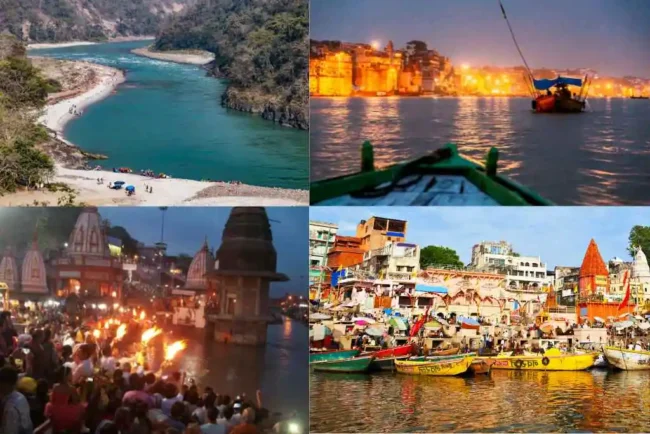The Mighty Ganga: A Journey Through Geography, Culture, and Challenges
The Ganga, also known as the Ganges, is not just a river; it’s the lifeblood of India. Spanning 2,525 kilometres (1,569 miles) from the Himalayas to the Bay of Bengal, it’s the country’s longest river and the third-largest by discharge volume. But beyond its physical characteristics, the Ganga holds immense significance in Indian culture, religion, and ecology. Here’s a detailed exploration of this remarkable river:

A Geographical Journey:
- Birthplace in the Himalayas: The Ganga’s journey starts with two source streams – the Bhagirathi and Alaknanda rivers. Bhagirathi originates from the Gangotri Glacier, nestled amidst the majestic peaks of the Himalayas in Uttarakhand. Alaknanda, considered the “true source” by some, emerges near Badrinath. Their confluence at Devprayag marks the official beginning of the Ganga.
- Flowing Through the Gangetic Plains: As the Ganga descends from the mountains, it carves its way through the vast Gangetic Plains. This fertile region, formed by centuries of alluvial deposits, is home to over 40% of India’s population and is crucial for the country’s agriculture.
- Joining Forces and Reaching the Sea: The Ganga’s journey is joined by numerous tributaries, including the Yamuna, Ghaghra, Son, and Kosi. Finally, after flowing through Uttar Pradesh, Bihar, Jharkhand, West Bengal, and Bangladesh, it merges with the Brahmaputra River to form the world’s largest delta before emptying into the Bay of Bengal.
Also Read
The Ambubachi Mela 2024: Celebrating the Divine Feminine at Kamakhya
A Cultural and Religious Tapestry:
- The Sacred River: For Hindus, the Ganga is the holiest river. It’s believed to be the embodiment of the goddess Ganga, a celestial entity who descended from heaven to purify the earth. Millions of devotees undertake pilgrimages to bathe in its holy waters, seeking absolution from sins and attaining spiritual merit.
- Holy Cities and Rituals: The banks of the Ganga are dotted with holy cities like Varanasi, Haridwar, Prayagraj (Allahabad), and Rishikesh. These cities are centres of pilgrimage and host vibrant rituals like aarti (worship with lamps), evening prayers, and the grand Kumbh Mela, the world’s largest religious gathering.
- Symbol of Life and Renewal: The river is deeply ingrained in Indian culture. It’s associated with life, fertility, and purification. Rituals involve offerings to the river, and its water is used for religious ceremonies and everyday life, despite growing concerns about pollution.
Ecological Importance:
- A Lifeline for Millions: The Ganga is a vital source of freshwater for irrigation, drinking water, and industrial use for millions of people living in its basin. It sustains diverse ecosystems, supporting a variety of flora and fauna, including the endangered Gangetic dolphin and the Gharial crocodile.
- Challenges and Threats: Unfortunately, the river faces several environmental challenges. Industrial waste, untreated sewage, and agricultural runoff have polluted the Ganga, endangering its aquatic life and impacting water quality. Deforestation and climate change further affect its water flow and ecosystem health.
Conservation Efforts and the Future:
- The Need for Action: The Ganga’s deteriorating condition has prompted numerous initiatives. The National River Conservation Directorate of India has launched the “Namami Gange” program, a multi-billion dollar project aimed at cleaning the river and restoring its ecological balance.
- Challenges and Solutions: However, cleaning the Ganga requires a multi-pronged approach. Stricter regulations on industrial waste disposal, improved sewage treatment infrastructure, and public awareness campaigns are crucial. Additionally, sustainable agricultural practices and promoting water conservation are essential.
- A Shared Responsibility: Reviving the Ganga is not just a government task; it requires collective effort. Engaging communities living along the riverbank and promoting responsible water usage are key to its success.
The Ganga is a complex entity – a life-giving river steeped in cultural significance and facing critical environmental challenges. Its future depends on our ability to balance its religious importance with the need for responsible stewardship. By undertaking conservation efforts and promoting sustainable practices, we can ensure that the mighty Ganga continues to flow, nourishing both the physical and spiritual landscape of India for generations to come.
Further Exploration :
This essay provides a broad overview. To delve deeper, consider these aspects:
- The Rich Mythology of the Ganga: Explore the legends and stories associated with the river’s origin and its role in Hinduism.
- The Socioeconomic Impact of the Ganga: Examine how the river supports agriculture, fishing communities, and livelihoods along its basin.
- The Ganges River Dolphin: Learn about this endangered species and the efforts to conserve it within the Ganga ecosystem.
Ganga in Bangladesh
The Ganga River undergoes a name change after entering Bangladesh. Here’s a breakdown:
- India: Known as the Ganga throughout its journey within India.
- Bangladesh: Upon entering Bangladesh, the main branch of the Ganga is called the Padma River.
The Padma continues its flow through Bangladesh, eventually joining the Jamuna (a distributary of the Brahmaputra) and the Meghna (another Brahmaputra distributary) to form a vast delta before emptying into the Bay of Bengal.
